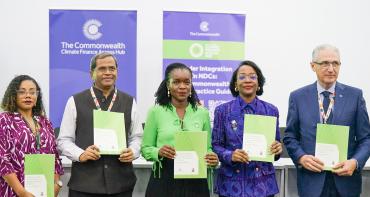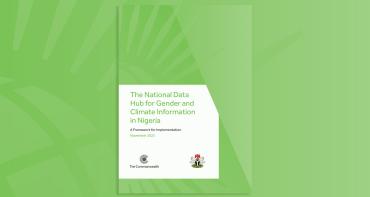<em>A blog by Christine Awiti, Economic Advisor, Commonwealth Secretariat</em>

Elevated debt levels have become a key global economic indicator to watch. All signs point toward the unfolding COVID-19 pandemic as the principal cause, or so it seems at least at first glance. Certainly, a contraction in gross domestic product (GDP) levels have led to a rise in debt as a percent of GDP. In addition, increase in government spending to combat the pandemic, with a simultaneous drop in revenue exacerbated worsening debt indicators.
While the pandemic has perhaps amplified the underlying debt fundamentals, a critical analysis reveals an upswing in debt to GDP levels over the past decade up to 2019. Within the Commonwealth, the average debt to GDP level increased from 52.0 per cent of GDP in 2011 to 60.2 per cent of GDP in 2019, marginally breaching the recommended 60.0 per cent of GDP debt levels for market access countries, or the International Monetary Fund’s non PRGT* countries.
Increased frequency and intensity of climate disasters
This average masks regional differences. The Caribbean’s debt to GDP ratios, for instance, averaged 74.1 per cent in 2019. However, the Caribbean’s elevated debt levels are a direct result of fiscal policy responses to contain damage and restore economies from climate-related shocks. Both within and without the Commonwealth, small states and increasingly least developed countries, are locked in a climate vulnerability cycle that threatens lives and livelihoods and has adverse impacts for the natural environment.
In reality, the frequency and intensity of climate induced disaster events have risen. The Caribbean small states experienced three destructive hurricanes in 2017. While the intensity was of similar magnitude to a hurricane that was last felt in 2012, which was 5 years apart, the next hurricane of similar intensity was felt two years later in 2019. Consequently, despite deliberate efforts to contain debt levels through fiscal consolidation, fiscal policy reaction to contain the damage from climate related events, and to restore economies, left debt levels elevated.
Since a majority of small states are middle income market access countries, the market automatically prices risk from climate related events, resulting in expensive debt. As the protracted pandemic unfolds, small states positions are arduous, with large proportions of revenue collected apportioned towards debt finance, as spending on pandemic mitigation measures trend upwards. Meanwhile, despite commendable efforts by the international community at intervention, financing options remain limited.
Innovative financing, resolving the dual threat
Recognising the magnitude of the current and projected impacts of climate change, small and the vulnerable countries have initiated processes of increasing the ambition of their climate action through the nationally determined contributions (NDC). The pandemic has amplified climate impacts despite commendable efforts. Climate finance requirement for these countries becomes more apparent.
Consequently, innovative solutions are required to address these complex and interconnected global challenges. Instruments such as the Debt for Climate (DFC) Swaps that strengthen both debt sustainability and put in place measures to mitigate and adapt to climate change, may be just the solution to the dual threat.
In designing a DFC, three key considerations are:
- Debt aspect, including, debt levels and debt service payments;
- Participating Institutions (bilateral, multilateral and private sector creditors); and
- Use of the proceeds from debt, ideally for climate mitigation and adaptation projects.
Nevertheless, in the wake of the pandemic effects on economies, two angles will be imperative in spending decisions. First, scarcity of resources against competing needs will need to be considered carefully in order to strengthen sustainable recovery. Second, the cost of debt, how it influences debt sustainability, and therefore macroeconomic stability, will be important to ensure a stable recovery.
From the second angle therefore, it can be argued that if the effects of a shock such as the pandemic to an economy drives down government bonds, then proceeds from the ensuing swaps would not be due to climate related events. Therefore, a question arises as to where such proceeds should be spent. Given the first angle, ideally it would be to the spending that offers the highest returns.
The argument for DFC Swaps and spending on climate related projects over other expenditure categories, is the ability of DFC swaps to leverage finances from climate funds and multilateral sources, that would increase the scale and impact of climate actions. Large scale climate related projects would include climate mitigation projects such as switching from brown to green energy. Adaptation projects such as wetland restoration that strengthen resilience could also be considered as options for climate related projects.
Large climate funds, such as the Green Climate Fund, are considering DFC swaps as a new instrument. The Commonwealth Climate Finance Access Hub took an initiative to build human and institutional capacities of the Government of Belize and other Caribbean countries on the most recent developments in DFC swap.
Suffice to say, the DFC swap instrument should ideally be applicable to countries that are grappling with the dual threat of climate related events and elevated debt levels due to responses to current and projected climate challenges. In addition, and important consideration should be given to middle income countries that have limited sources of financing with debt sustainability concerns, high debt service payments, and countries that are ideally not facing a liquidity crisis.
Ultimately, policies that not only strengthen adoption of, but also ease implementation of climate projects; in addition to adoption of transparency policies by debtor countries, will make for a more convincing lot to attract participating creditor institutions, as well as climate funds and multilateral resources. A necessary milestone in the struggle against the dual threat.



